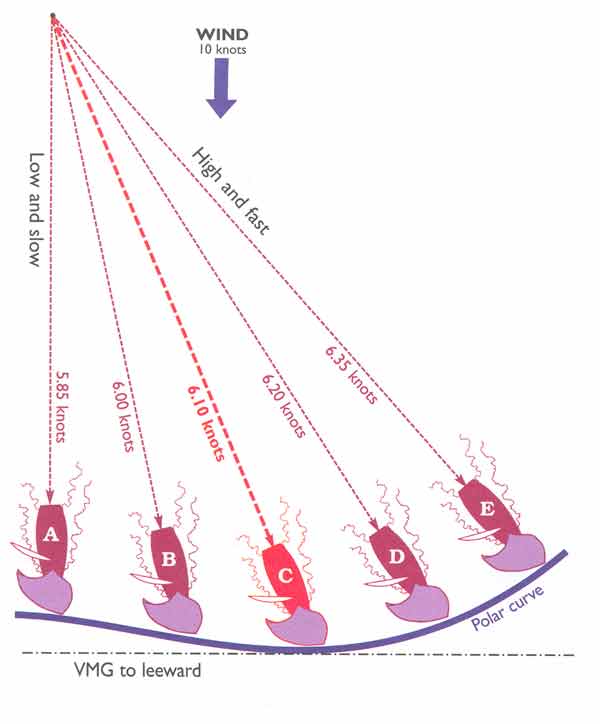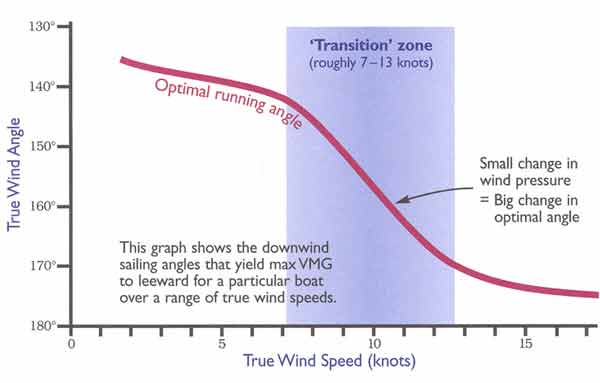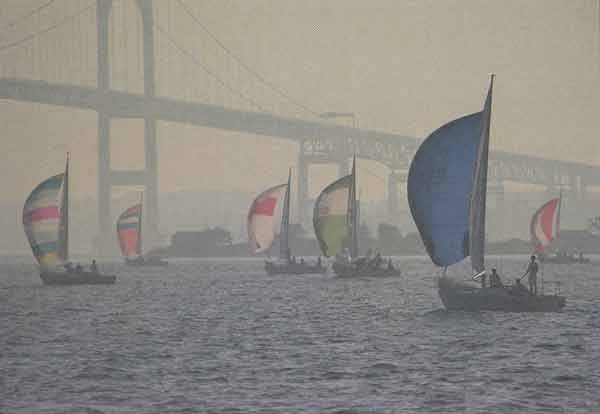Pick a Fast Angle for Running
by David Dellenbaugh
When you want to go fast on a run, it’s important to get just the right trim
for your sails and your boat. But that is not enough. Perhaps the most critical
ingredient for downwind speed is finding the correct wind angle to sail.
 |
| When you're sailing downwind, you have
a choice of many different course to steer. You can sail low slow (A),
high and fast (E), or anywhere in between. You can go faster by sailing a
higher angle, of course, but this also means you will be heading farther
away from the leeward mark.
For any boat and wind condition, there is usually one combination of
boatspeed and wind angle (C in this graph) that will give you the best VMG
(velocity-made-good) to leeward. Unless you need to go high or low for
tactical/strategic reasons, you should always try to find this optimal
combination of speed and angle when you're running. |
Locating the best angle is not so difficult when you’re sailing upwind. The
closehauled “groove” (the heading that gives you optimal performance to
windward) is fairly well-defined and stays pretty much the same even as the wind
increases or decreases. The front of your jib gives great feedback about whether
you are sailing too high or too low. And there are many other clues to help you
find the best closehauled angle, including the tug of windward helm, a steady
angle of heel, and the constant feel (and angle) of breeze on your face.
Almost all of these things are missing when you sail downwind, however, and
that makes the downwind “groove” less well-defined. On a run, you must choose
from among a wide range of angles to sail, and this makes it harder to know
whether you are steering the best course possible. In addition, your ideal
sailing angle changes more frequently and dramatically when you are sailing
downwind.
Because of all this, you need as much help as possible in finding the true wind
angle that will get you downwind the fastest. Here are three ways to do a good
Job:
Feel
1. “Feel” your boat - As Bill Murray says in Caddyshack, a comedy about golf,
you must “be the ball.” In sailing, try to be the boat. Almost every top sailor
is very good at “feeling” his or her boat when racing. They are able to use
their senses of touch, balance, sight and sound to know how fast the boat is
going through the water, how much pressure is in the sails, how far the boat is
heeled, how much helm there is, and so on. If you want to feel your way to the
best angle downwind, you must be able to judge subtle changes in speed and
angle. If you can bear off slightly without losing much speed, then that is
probably a good thing to do. Likewise, if you can head up a little and increase
your speed noticeably, you are probably going in the right direction.
The helmsperson and spinnaker trimmer (if you have one) must be able to see
and sense the amount of wind pressure in the sails since this will help you find
the optimal angle. If you feel increased pressure in your spinnaker, for
example, you can probably bear off. Less pressure means you should head up.
Of course, you shouldn’t rely entirely on your senses, even if you’re the
world’s best sailor. your ultimate goal is not sailing the boat so it feels
right, but beating the other boats. It would not be useful to set up the boat so
it feels good but goes slower than the boats around you. That’s why you must
rely on other clues as well.
Check
2. Check other boats - Since your primary goal is to beat the competition, don’t
get your head stuck inside your own boat. It doesn’t really matter how good or
bad your boat “feels”, as long as you are performing relatively better than you
competitors. In fact, sometimes when the boat feels “bad” you may actually be
doing quite well.
Watching the other boats is especially helpful for figuring out which angle
is best to sail downwind. Pick one course and sail this for a while, watching
your performance compared to near by boats. Are you sailing higher or lower than
them? How is your speed through the water? Which boat is making the best VMG to
leeward? Then sail a little higher or lower and see what happens. Does this new
angle improve your VMG relative to the other boat(s)?
Keep experimenting until you find the angle that gives you the best relative
performance in the existing wind velocity. While you are going fast, try to
remember how the boat and sails look and feel.
 |
| On a run, the angle you
sail to maximize you VMG to leeward depends a lot on wind velocity. In
heavy air it’s fast to sail almost dead downwind, while in light air you
must sail a lot higher. However, this relationship is not linear. In the
lighter (under 7 knots) and heavier (over 13 knots) wind ranges, changes
in windspeed have only a modest impact on your ideal sailing angle (see
graph). In the middle range, however, a small increase or decrease in wind
speed can change your optimal sailing angle significantly. When you are
sailing in this ‘transition’ zone, you must be very sensitive to changes
in the wind - otherwise you will be sailing at a less than optimal angle
and speed. |
Instruments
3. Instruments - If your boat has the luxury of instrumentation, this is another
resource to help you find the optimal angle downwind. By displaying your VMG to
leeward or your downwind target speed, you can figure out pretty quickly which
true wind angle will give you the best performance.
By tuning in the the feel of your boat, the relative performance of other
boats and your instruments, you have at least three different ways to help find
your best downwind angle. In the ideal world, use as many of these as possible
and don’t rely on just one.
Once you find a good angle for going fast downwind, don’t just sit back,
relax and open up the cooler. As I mentioned before, your optimal angle is very
sensitive to changes in wind velocity, especially if you are sailing in the
“transition” range of 7 to 13 knots of wind (see diagram above). Since the wind
is always changing, you must keep your head out of the boat and be ready to sail
higher (in a lull) or lower (in a puff) to maintain your best VMG.
When I’m sailing upwind, I always try to point a little higher without losing
speed. Downwind I always try to sail a little lower. Lower is good (in most
situations) because it takes you more directly toward the leeward make. However,
you have to be careful that you don’t get going too slowly.
Don’t even think about sailing lower unless your boat feels good (i.e. you’re
relatively fast with the sails pressured up). Then bear off slowly (adjusting
your sails accordingly) until you just start to feel the sails lose pressure and
the boat slow down. At that point, head up again to maintain your speed.
While you are searching for the right angle, make sure to check your
performance against that of nearby boats. Some boats like to sail high,
especially in light air of planing conditions, while others go faster dead
downwind, or even by the lee. The only way to know which is better is to try
different things and keep evaluating.
|
Dave publishes the newsletter Speed & Smarts. For a
subscription call: 800-356-2200 or go to
www.speedandsmarts.com
|


